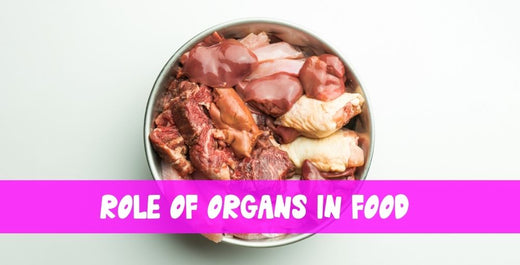
Organs: Add Magic to Your Dog’s Food
Share
Key Points

- Organs or offal are internal organs of animals, used as human food.
- These are more densely nutrient packed than lean muscle meat.
- Rotation and feeding in moderation help them deliver optimal nutrition.

Do you feed organs (offal) to your dog? Yay or No Way?
Many of us may find them smelly or unappealing. However, the nutrition they deliver to the body far outweighs their looks or smell! Being highly nutrient-dense meats that you can offer to your dog.
There are many varieties that dogs can eat from commonly available meat sources. Examples: liver, gizzards, heart, lungs, kidney, trachea, green tripe, brain, spleen, etc. Meat sources vary from location to location. Few that are easily accessible are chicken, duck, buffalo, etc. The top 3 that can immensely boost your dog food’s nutrient profile are:
Liver
One of the best organ meats for dogs, liver is a rich source of Vitamin A, B12, Folate (B9), Riboflavin (B2), Niacin (B3) which help in maintaining vision, healthy skin, and immune system, red blood cell and energy production along with proper functioning of the nerve system. Buff liver is a good source of Vitamin D. It includes minerals like iron, zinc, selenium, and copper among others. It is great for dogs with anemia due to iron and B12 content.
Gizzards
Gizzard is akin to the stomach, located in the digestive tract of chicken and is a rich source of protein. When added to the dog’s meal, they also deliver iron, taurine, and zinc when consumed. They are an excellent source of glucosamine, which is important for joint health.
Heart
It is a rich source of high-quality protein, essential for muscle development, repair, and overall bodily functions. Loaded with B vitamins, such as B12, riboflavin (B2), and niacin (B3), it is important for energy metabolism and overall health along with minerals like iron, zinc, phosphorus, and selenium. Buffalo heart may contain Coenzyme Q10 (CoQ10), an antioxidant that supports cellular health. Chicken heart contains natural taurine, an amino acid essential for heart health.
We know that quality meat in India is expensive. And food cost increases significantly if you have a large or extra-large dog. And over 23% of the dog owners that we spoke to claimed to feed organs as the only ingredient in 2 or more meals that they feed their dog during the week. That might cause intolerance due to overconsumption. Treat them like supplements – a little goes a long way. And hence, moderate and consistent feeding is the right approach.
Serve Them Right
All organs must be steamed or lightly cooked before feeding. Unless the source of meat is identified as germ-free, clean, and chemical-free, no meat or organ should be fed to your dog without cooking. In case you need to freeze store, they must be cooked and frozen. If stored raw, they must be cooked straight from the freezer. Caution: Frozen meat of any kind must not be thawed and refrozen. It impacts viability.
Some easy percentages to help you with adding them to your pup’s meals. Liver should form no more than 5% of your dog’s daily diet in weight. Gizzards and heart can make up to 10% of the diet. Introduce each new variety in small quantities. Add type at a time, to the meal, to identify intolerance.
Remember to rotate meat sources and types of organs for deriving complete nutrition. For some dogs, this inclusion in their diet may need some getting used to. Be prepared for some change in stool consistency in the beginning. However, in case of a persistent upset stomach or drastic change in stool consistency, please discontinue feeding. If symptoms persist, keep your pup hydrated and consult with your vet.
To serve the right meal to your dog, call us at +91 99205 68815 or fill up the Pet Profile form on this page.


